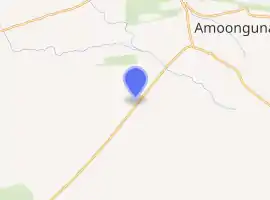Alice Springs Youth Detention Centre
The Alice Springs Youth Detention Centre formerly known as Alice Springs Juvenile Holding Centre is an Australian medium to maximum security prison for juvenile males and females located in Alice Springs, Northern Territory, Australia.

| |
| Location | Alice Springs, Northern Territory |
|---|---|
| Coordinates | 23°51′30″S 133°47′57″E |
| Status | Operational |
| Security class | Maximum, for juvenile males and females |
| Capacity | 10 |
| Opened | September 1998[1] |
| Managed by | Northern Territory Correctional Services |
Facilities
The centre was designed for use as a short-term holding and remand centre for up to four days, and could originally hold up to ten juveniles of either sex; longer remand periods or sentences were moved to Don Dale Juvenile Detention Centre in Darwin.[1][2]
Expansion and re-configuration of the facility allowed for longer-term detention of up to 18 detainees: a maximum of 15 males in eight rooms, and up to three females in three rooms in a separate wing. However by 2018 there was overcrowding at the facility, with 24 youths held there.[3] Improvements made after the Royal Commission into Juvenile Detention had been made, including provision for school lessons; however in June 2019 it was found that the Centre was failing to provide nearly half of the classes.[4]
Four Corners program
Graphic footage of repeated abuse of children at Don Dale Juvenile Detention Centre and in Alice Springs was featured in ABC's Four Corners episode "Australia's Shame", which aired on 25 July 2016.[5] The program also showed a 17-year-old boy shackled and hooded in a chair in Alice Springs (adult) correctional center.[6] The UN High Commissioner for Human Rights said it was "shocked" at the "appalling treatment" of the detainees, which violates the Convention against Torture and Other Cruel, Inhuman and Degrading Treatment, to which Australia is party.[7]
Following national outrage, Prime Minister Malcolm Turnbull announced a Royal Commission into Juvenile Detention in the Northern Territory.[8] John Elferink was sacked as Corrections Minister the morning after the program aired. The corrections and justice portfolios were taken on by Northern Territory Chief Minister Adam Giles.[9] Use of restraint chairs and spithoods were then suspended.[10]
See also
References
- "Annual Report" (PDF). Northern Territory Correctional Services. 2001. p. 21. ISSN 1322-6312. Archived from the original (PDF) on 12 April 2011. Retrieved 10 May 2012.
- "Juvenile Justice". Northern Territory Government: Department of Justice. Archived from the original on 4 July 2007. Retrieved 8 July 2007.
- Gibson, Jano (31 July 2018). "Alice Springs Youth Detention Centre at 'crisis point', should be shut, NT Government warned". ABC News. Australian Broadcasting Corporation. Retrieved 8 October 2019.
- Hanifie, Sowaibah (22 June 2019). "Youth detention centre failing to provide children with enough lessons, reports find". ABC News. Australian Broadcasting Corporation. Retrieved 8 October 2019.
- Caro Meldrum-Hanna; Elise Worthington. "Evidence of 'torture' of children held in Don Dale detention centre uncovered by Four Corners". Four Corners. Australian Broadcasting Corporation. Retrieved 27 July 2016.
- Doran, Matthew; Anderson, Stephanie. "Royal commission into NT youth detention to investigate possible human rights breaches". ABC News. Retrieved 29 July 2016.
- "UN 'shocked' at Don Dale inmate abuse". Sky News. 30 July 2016. Retrieved 30 July 2016.
- Hunter, Fergus (27 July 2016). "Malcolm Turnbull calls royal commission into youth abuse at Northern Territory's Don Dale detention centre". Sydney Morning Herald. Retrieved 28 July 2016.
- "John Elferink sacked from Corrections in wake of Four Corners report; Adam Giles alleges culture of cover-up". ABC News. 26 July 2016. Retrieved 28 July 2016.
- Davidson, Helen (28 July 2016). "Northern Territory halts use of restraint chairs and spithoods in youth detention". Guardian Australia. Retrieved 28 July 2016.